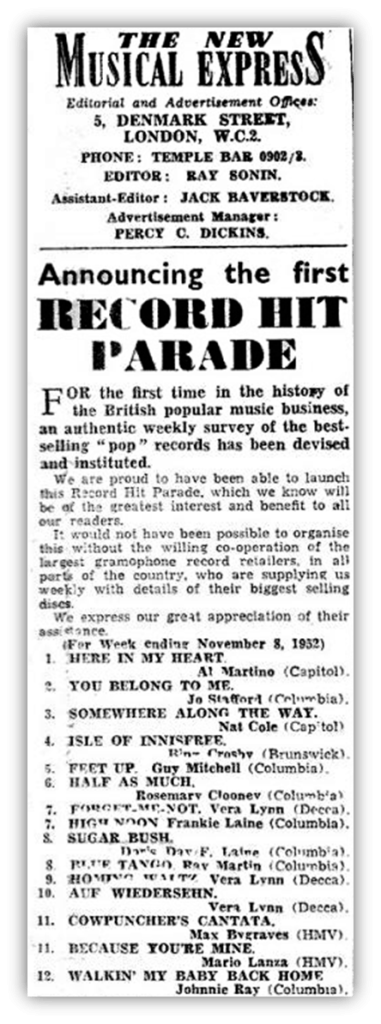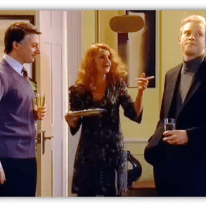We’ve reached the 1950s.

Where the chart era started.

And a new invention called the teenager was all the rage.
Whether teenagers would have any interest in these, is another matter:

Lord Rockingham’s XI
“Hoots Mon”
#1 – 1958
Hate to break it you: but there’s no Lord Rockingham. That’s showbiz: you can’t trust anyone.
Actually led by Harry Robinson, who went onto write string arrangements for Nick Drake and Sandy Denny.

As well as composing film scores and even screenwriting for a number of Hammer Horror films. Quite the resume.
The XI were house band for early TV music show Oh Boy! Surprisingly progressive for the time; they were mixed race and mixed gender. Like Sly And The Family Stone a decade earlier.
It’s wildly exuberant and instantly memorable for both the tune and the cod-Scottish interjections. The wild exuberance may suit Sly, the Scottish accent not so much.

Bernard Bresslaw
“Mad Passionate Love”
#6 – 1958
A surprising title for the 1950s. On closer inspection it’s strictly PG rated, as it concerns the courtship of two birds.

As may be immediately apparent Bernard is a comic actor, rather than a singer.
You see, it’s funny because of the disconnect between the title and the detachment of Bernard’s droning delivery. Or it’s meant to be anyway. Perhaps you had to be there.
Unlikely trivia: this was co-written by Richard Sherman. Before he wrote all those Disney classics. This is not one of his best efforts, but you’ve got to start somewhere.

Johnny Dankworth
“Experiments With Mice”
#7 – 1956
Another title to wrongfoot you. It suggests there’s something unpleasant going on. Not a bit of it, the experiments are to play around with “Three Blind Mice” in a jazz style, imagining the tune reinterpreted by a variety of jazz performers.
Probably the most musically accomplished of this whole series. As a jazz skeptic, even I find it pleasantly diverting.

The Goons
“I’m Walking Backwards For Christmas”
#4 – 1956
Despite the title, this is not a Christmas record. It was released mid summer. Then again, maybe it is. Logic and reason are not high on The Goons agenda. As you will no doubt have established with a listen to this. Without prior Goon exposure you can probably file this one under: baffling.
The Goons come with a big reputation and are at the head of the lineage of surreal British comedy.
Regarded as the starting point from which Monty Python sprang and influencing any number of British comedy acts that followed.

Somehow they found mainstream success, also marking out a place in history as their career was mostly built on a radio series that ran from 1951 to 1960.
It was the end of the age where radio was the dominant cultural medium before TV took over.
There were originally four Goons. But Michael Bentine left after two series and before this was recorded. That left Peter Sellers, Harry Secombe and the creative engine of the group: Spike Milligan. “I’m Walking Backwards For Christmas” is largely Spike, with a bit of Sellers at the end. It’s got all their trademarks of silly voices, imagery and a cavalier approach to formal structure.
No surprise, the one-man production machine that is George Martin was on duty for many of their records. As big Goon fans, it helped sell the Beatles on him.
Another fan was a young King Charles:

…who would go onto become good friends with Spike. A friendship that was maintained despite the then 76 year-old Spike’s reaction to being read a congratulatory letter from Charles live on primetime TV on receipt of a Lifetime Achievement accolade at the British Comedy Awards.

Probably the only person that could get away with calling the future monarch; ‘a grovelling little shit’.
Spike apologised later – though still with mischief, as it included asking; ‘I suppose a knighthood is out of the question?’
Irreverent to the end, his headstone carries the inscription; ‘I told you I was ill.’

Winifred Atwell
“Let’s Have A Party”
#2 – 1953
Evidence that the world was changing fast. Winifred came to Britain from her native Trinidad in 1945 and quickly became a star. Coinciding with the new chart era, she was one of the biggest chart acts of the 50s with two #1s and 11 top 40 singles, the last in 1959.

She’s also the first black artist to top the British charts, and inspired Elton John, Keith Emerson and Rick Wakeman to play piano.
Yet, anyone under 60 is unlikely to know anything about her, so quickly did the charts move on. The music certainly sounds like an entirely different era. She was in a similar vein to Mrs. Mills that would follow her, good time piano music, vocal free for listeners to provide their own accompaniment. Harking back to the times people made their own entertainment and every good parlour had a piano.

Max Bygraves
“Cowpunchers Cantata”
#7 – 1952
This may sound vaguely familiar. Though without context, it feels like a load of ideas thrown together with little regard for narrative.
It makes no sense – but in a completely different way to The Goons.

Turns out: That man George Martin was in charge again. It has a little footnote in history as the first track recorded at Abbey Road studios to appear on the singles chart.
Partly because it appeared in the very first NME singles chart in November 1952.
The nonsense makes more sense when revealed that its a medley parodying the Frankie Laine songs; “Mule Train,” “Cry Of The Wild Goose,” “(Ghost) Riders In The Sky” and “Jezebel.”
Max was a true variety act. Comedy, acting, singing, game shows and is one of the most successful acts on the British charts never to have touched any Billboard chart. Which may not surprise you after you hear this.

Alma Cogan
“Never Do A Tango With An Eskimo”
#6 – 1955
Seems unfair on Eskimos. Maybe they don’t want to Tango with you, either.
Typical of the times, many of Alma’s hits were covers of popular American tunes but this one was an original. Written by English songwriter Tommie Connor who you’ll all be familiar with as writer of…anyone?…anyone….?

“I Saw Mommy Kissing Santa Claus.” Which comes as news to me given that I’ve never come across anyone in Britain that has a ‘mommy’ and have always associated the song as American.
Back to Alma: she was known as the girl with the giggle in her voice and was at one point the highest paid entertainer in Britain. Unfortunately the 60s came along and despite a friendship with The Beatles her career on the pop charts was over. Even sadder, she died of ovarian cancer at only 34 in 1966.

Frankie Vaughan
“Istanbul (Not Constantinople)”
#11 – 1954
Speaking of covers of popular tunes from America… Such was their prevalence, it’s only fair to reflect that rich seem. Here’s a cover of The Four Lads geographical nomenclature, released a few short months after the original. Maybe its regional bias, but I prefer Frankie’s cut. It leans into the exotic and there’s a lot more character to his exaggerated enunciation.
Frankie would provide inspiration to a new wave of performers in the 80s thanks to a newspaper headline referring to him starring in Marilyn Monroe vehicle Let’s Make Love

Step forward: Frankie Goes to Hollywood.
Frankie also achieved something many of the other big acts of the 50s couldn’t do. I wouldn’t say he remained relevant as a pop star, but: his 29 top 40 hits extended all the way to 1968.

Lonnie Donegan
“Cumberland Gap”
#1 – 1957
Then there’s this dismantling of the folk song popularised by Woody Guthrie.
Back in 2021 I included Lonnie with “My Old Man’s A Dustman.” I commented then that his first #1 was a raucously basic take on Cumberland Gap. So here it is, with the bonus of a TV performance.
This is novelty in that there really was nothing else like it. Certainly not from a British act and not spending five weeks at Number One.

Lonnie made his chart debut a few months before Elvis in 1956, though by the time this appeared a year later when Elvis was causing the same palpitations in the youth of Britain.
Elvis was far away, untouchable and exotic. Lonnie was right here, and the primitive hammering away of Cumberland Gap was the ultimate call to arms to that youth. This was attainable. Showing what was possible and how easy it really could be.
It quickly winds itself up into a wild thrash that could be a precursor to garage rock with Lonnie singing like a man in a hurry to inspire the next generation who in a few years would eclipse him entirely.

Tommy Steele
“Little White Bull”
#6 – 1959
Tommy was Britain’s first rock and roll star. Debuting with “Rock The Caveman” in 1956. By 1959 he had moved into all round family entertainer mode.
This is the stirring tale of a little white bull who was sad because only black bulls were allowed to take part in bullfights. Until he finds his courage and proves that he can be a brave bull, too.

Written by Lionel Bart, doyen of British musical theatre including award winning writer of Oliver!
“Little White Bull” wasn’t award winning. It was written for the film Tommy The Toreador in which Tommy gets into shenanigans when stranded in Spain after saving the life of a bullfighter.
It conveniently ignores the fact that the likely outcome for the little white bull is a death sentence once it gets in the bullring. Nevermind though, just a bit of fun isn’t it?

Singing Dogs
“The Singing Dogs Medley”
#13 – 1955
You might want to let the dog out into the backyard before you play this one.
Simpler times.
This one is just as simple. Some dogs singing. “Singing” is pushing it.

The dogs: Dolly, Pearl, Pussy, Caesar, and King.
To give them their credit, they perform Pat-A-Cake, Three Blind Mice and Jingle Bells.
And yes, one of the dogs was called Pussy. To be fair this was the 50s but even without the connotations that word has now, its a name likely to give a dog an identity complex.

The Stargazers
“I See The Moon”
#1 -1954
Leaving you with another cover of a popular American tune. The Mariners’ US release was a fairly straight version. Whereas The Stargazers deliver it in a manner that suggests drunken amateur singalong. They had been the first British act to reach #1 and this gave them their second.
The first was standard early 50s pop. But as was in the way back in the day, The Stargazers liked a bit of variety.

They started out backing up Petula Clark in 1950, which is a fact that makes me look twice, considering how old that makes Petula and that by the time of “Downtown,” she was past 30.
A sign of the times that they were happy in the role of variety act, mixing it up between comedy, family entertainment and pop. It sounds like they had a good time recording it anyway.
And… That leaves one more episode to go:

As I delve into the music halls and variety acts of the first half of the 20th century.
There’ll be wit, innuendo and impenetrable accents.
Stay tuned one last time.
Let the author know that you liked their article with a “Green Thumb” Upvote!





None of these songs reached the Hot 100. Three of the artists did, however, with other songs.
Lonnie Donegan and his Skiffle Group reached the top five in 1961 with “Does Your Chewing Gum Lose It’s Flavor (On The Bedpost Over Night)”
Frankie Vaughan reached #100 for one week in 1958 with “Judy”
Lord Rockingham’s XI did slightly better that same year, charting for one week at #96 with “Fried Onions”
https://www.youtube.com/watch?v=PpszFxj8Qbk
Frankie Vaughan’s Hollywood career went about as well as his Billboard career. He had one more starring role in The Right Approach after his Marilyn Monroe co-star. I haven’t heard of either. Still, one week at #100 is better than 99.9+% of the population have managed.
Having listened to Judy I’m baffled as to why that got him his one Billboard appearance.
Good work, JJ! Here’s Spike Milligan’s acceptance speech. Slight correction though, the actual quote is “little groveling bastard,” which is even funnier.
https://youtu.be/TkOAUht3G5o
I haven’t heard most of these before but I’m pretty impressed with “Experiments With Mice” because it nails the styles of the various Jazz artists. Of course, it’s only funny if you’re familiar with those artists, but Johnny Dankworth, if that’s his real name, did a great job.
Also, this is an excellent take on Lonnie Donegan. He was revered by all the British Invasion bands even as they, as you say, eclipsed his star. He put out an album in 1978 featuring Ringo Starr, Elton John, Brian May, and other 60s and 70s celebs. It’s definitely worth a listen.
Thanks for the correction, I should have known. I remember watching it live, at that time it was tradition for there to be one jaw dropping moment each year at the awards. The reactions of everyone in the room helps make it. There was no cancelling Spike but Julian Clary didn’t fare as well the year before with his off the cuff remark about Norman Lamont (at the time the Chancellor of the Exchequer, i.e. number 2 to the Prime Minister) who was in the audience. It took a while for his TV career to get back on track.
https://youtu.be/iAU7pATH5_M?feature=shared
Johnny Dankworth is his real name. Though by the end of his life it was Sir John Dankworth for his extensive contribution to music and culture over his life.
My middle school English teacher introduced me to Lonnie Donegan in the late 80s. He never played us any of the records but he’d talk about this guy that inspired The Beatles and in his opinion was far better than them. Not quite the same musical ability but definitely inspiring. He was in the wilderness a long time but was getting his due towards the end of his life. I’ve not listened to that ’78 album but will see if I can track it down. There’s a huge range of compilations on streaming but can’t see that album in amongst them.
I’m generally pretty sour on many of these novelty songs, but Lonnie Donegan’s “Cumberland Gap” just blew me away! What a freight train explosion!
Oh, I did want to say something about Winifred Atwell.
I took piano lessons as a child, like many kids did in those days. One day I asked my teacher. Mrs Dilks, how she got started playing. Her parents had several of Atwell’s records and they inspired her to learn the instrument. As a seven-year-old American in the 1970s, of course I had never heard of Atwell. Mrs Dilks still had some of the records and played one for me. I was impressed, even if it wasn’t exactly my kind of music.
I didn’t hear or even think about Atwell again until a couple of years ago when I started reading Tom Ewing’s blog about UK #1s and she popped up.
Great example of how music finds its way across borders and turns up in unexpected places. As well as inspiring down through the generations.
I came across Winifred thanks to my 1988 British Book Of Hit Singles. Seeing her run of hits through the 50s was intriguing. The bare facts of those stats indicated she must have been a big star but there was no trace of that in the late 80s. In the pre-internet days there was no easy way of finding out about her so she remained a mystery for a long time.
What a great feature! As usual, there are some difficult to listen to material here…but then there’s great stuff like “Cumberland Gap” and “Experiments with Mice”. I like it.
Those singing dogs. Their full length version of “Jingle Bells’ still gets played occasionally here during the holidays. It does by ME anyways.
Looking forward to more.
Throughout the series there are some that I’ve known well and have heard many times. Whether I wanted to or not. Others I’ve only discovered in the course of writing this. Of the new discoveries I’ve listened to them all several times to get to know them….apart from Singing Dogs.
I’ve got part way through a few times and skipped forward to make sure there’s no surprises I’m missing out on but I can’t muster the resolve to get through the whole thing. You’re made of stronger stuff than me!
I’ve been playing it on a loop!
Are these dogs from Basildon? Because I just can’t get enough!
The 1950s was like the big bang of nutty and obnoxious novelty recordings. I love it so.
I’m walking backwards toward my Christmas playlist and adding a certain track.
That Max Bygraves tune was a bit like 60’s Scott Walker singing something by Raymond Scott.
Now, if you’ll excuse me, I must continue to drive my wife barking mad.
Thanks for the learnin, JJ!